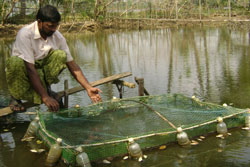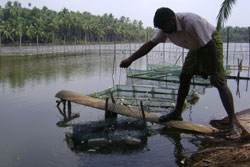
Fishery, both inland and marine, is the main source of livelihood for a large section of economically backward population in the country. Of late, it has become a powerful income and employment generator, thanks to the availability of technologies for using available water bodies. The Krishi Vigyan Kendra (KVK) of Indian Institute of Spices Research, a constituent body of Indian Council of Agricultural Research (ICAR) is giving training to rural youth in fishing fortune from the natural depositaries in water.
With a little care, proper planning and a strong determination for success coupled with timely technical advice can bring amazing results in aquaculture. Meet Mr. Manoj KK from Atholi in Kozhikode district of Kerala. Manoj’s backyard freshwater prawn hatchery unit is a model for many to emulate. It was 15 years back he began to ponder on exploiting the potential of fish wealth in his five acre pond.
“I started with tiger shrimp farming near my house. But changes in climatic conditions and emergence of white spot disease were the major setbacks,” says Mr. Manoj.This prompted Manoj to look into the potentials of brackish water fish culture. Brackish water breeds like Pearl Spot, Mullet and others were abundant in the lake. But, lack of scientific aquaculture practices often affected the productivity. So he approached the scientists at Peruvannamuzhi Krishi Vigyan Kendra for their help.
Prawn hatchery in the backyard

Knowing that brood stock (Mother prawns) is available in the pond, the scientists put forward the idea of setting up a hatchery for breeding giant fresh water prawn (Macrobrachium rosenbergii) in his backyard.
"Even though there is a huge demand for postlarvae of prawns, lack of availability is the main difficulty faced by many aspiring prawn farmers. Climate change and many other contributing factors severely affect the natural breeding of fresh water prawns in many areas. The only solution is to breed them in captivity", says Dr. B Pradeep, Subject Matter Specialist (Fisheries), Krishi Vigyan Kendra, Peruvannamuzhi." But a fresh water prawn hatchery requires an investment of lakhs of rupees. So we trained him breeding them in the backyard in small tanks", adds Dr. Pradeep. Last year, Manoj set up a hatchery in his backyard on an experimental basis, the first of its kind in Malabar area.
Manoj's determination and hard work plus timely scientific intervention showed good result. Though it was an experiment, he was able to sell around 5000 postlarvae prawns in the first stage. Manoj is planning to expand his hatchery. Recently, the Indian Institute of Spices Research had felicitated Manoj for his innovation in low cost fish culture cage production as part of the Karshika Sankethika Darshanam 2011, a farmers mela and technology expo.
Low cost cage for Pearlspot farming
Manoj's Pearlspot farming in fibre cages has also caught the attention of many. He has also developed a low cost fibre cage for growing Pearlspot in captivity. These fibre cages are made of fibre wire mesh. PVC pipes are used to float these structures on water. Since PVC pipes are very costly, he replaced them with empty plastic bottles, which will also help to float the cage on the water surface.
The production cost for a standard fish culture cage of 3X1X1 meter will be more than 3000 rupees where as this low cost model will cost only 1000 rupees. With a full-fledged Pearlspot hatchery unit, Manoj is producing around 20000 fingerlings in each breeding season.
(Source: NAIP Sub-Project of Mass Media Mobilization, DKMA with inputs from IISR)








Like on Facebook
Subscribe on Youtube
Follow on X X
Like on instagram